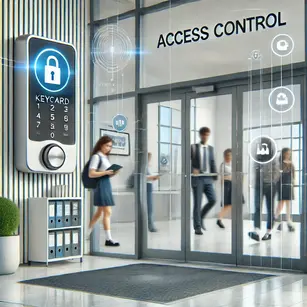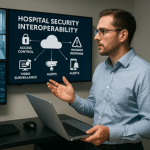
Safety and security are top priorities for any educational institution. From primary schools to large university campuses, ensuring that only authorized individuals can access facilities is essential for protecting students, staff, and valuable resources. A good, up-to-date access control system provides the foundation for a secure learning environment, helping schools manage access, monitor activity, and respond to potential threats. In this article, we explore the importance of access control systems in the education industry and how they contribute to a safe and efficient campus.
What Is an Access Control System?
An access control system is a security solution designed to regulate who can enter specific areas within a facility. In schools and universities, these systems often include technologies such as:
- Keycards or RFID Tags: Used to grant or restrict access to classrooms, labs, dormitories, and administrative offices.
- Biometric Scanners: Use fingerprints or facial recognition for high-security areas.
- PIN Pads: Require users to input a code for entry.
- Mobile Access: Allows authorized individuals to use smartphones for entry.
- Cloud-Based Systems: Provide real-time access monitoring and remote management capabilities.
By replacing traditional locks and keys, access control systems give schools greater flexibility and security, ensuring that only approved individuals can access specific areas.
Why Is an Access Control System Important in Schools?
- Enhancing Campus Security
Schools face a range of security challenges, from unauthorized intrusions to theft and vandalism. An access control system prevents unauthorized individuals from entering sensitive areas, such as classrooms, labs, or dormitories, ensuring the safety of students and staff. - Protecting Students and Staff
By limiting access to authorized personnel, schools can create a secure environment where students and staff feel safe. In the event of an emergency, such as an active threat, access control systems can help secure certain areas and prevent unauthorized movement. - Monitoring and Tracking Access
Modern access control systems keep detailed logs of who enters and exits specific areas. This data is invaluable for identifying potential security breaches or investigating incidents. For example:- Knowing who accessed a computer lab when equipment went missing.
- Tracking attendance or visitor activity.
- Restricting Access to High-Security Areas
Certain areas, such as server rooms, financial offices, or chemical labs, require additional security. Access control systems ensure that only individuals with proper clearance can enter these spaces. - Streamlining Visitor Management
Integrated access control systems can work with visitor management systems to ensure that all guests are registered and given temporary access to specific areas of the school. - Emergency Response and Evacuation
In emergencies, access control systems can lock down certain areas or open doors for faster evacuation. Real-time monitoring allows administrators and first responders to act quickly and effectively. - Eliminating the Hassle of Lost Keys
Traditional locks require physical keys, which can be lost, stolen, or duplicated. With access control systems, lost credentials (like a keycard) can be deactivated instantly, preventing unauthorized use.
Key Features of a Modern Access Control System for Schools
- Multi-Layered Authentication
Combine credentials such as keycards, PIN codes, and biometrics for added security. - Cloud-Based Management
Cloud-based access control systems allow administrators to manage permissions remotely, monitor activity in real time, and generate reports from anywhere. - Customizable Permissions
Tailor access permissions based on roles, schedules, or events. For instance:- Teachers can access classrooms during school hours.
- Maintenance staff can access utility rooms but not administrative offices.
- Integration with Other Security Systems
Access control systems can integrate with surveillance cameras, alarm systems, and fire safety systems for a comprehensive security solution. - Mobile Access
Mobile-enabled systems allow staff and students to use their smartphones for secure, contactless entry. - Real-Time Alerts
Receive notifications for unauthorized access attempts, door propping, or tampering.
Benefits of an Up-to-Date Access Control System
- Proactive Security
Prevent security incidents before they occur by controlling and monitoring access to critical areas. - Cost Savings
While upgrading to a modern system requires an initial investment, it reduces long-term costs associated with rekeying locks, replacing stolen items, or responding to security breaches. - Improved Efficiency
Streamlined access control reduces administrative burdens, such as distributing and tracking physical keys or managing after-hours access. - Enhanced Reputation
A school that prioritizes security demonstrates its commitment to the safety and well-being of its students and staff, fostering trust among parents and the community. - Adaptability to Changing Needs
Modern access control systems are scalable, allowing schools to add users, expand coverage, or integrate new technologies as needed.
Challenges and Considerations
- Budget Constraints
Many schools operate on tight budgets, making it difficult to invest in advanced systems. However, grants and security-focused funding can help offset costs. - Training and Adoption
Staff and students need training to use access control systems effectively. User-friendly systems and regular training sessions can ease this transition. - System Maintenance
Regular maintenance and software updates are essential to keep systems functional and secure. - Privacy Concerns
Schools must ensure that access data is stored securely and used responsibly to comply with privacy laws.
Best Practices for Implementing Access Control Systems in Schools
- Conduct a Security Assessment
Evaluate the school’s current security measures and identify areas where access control is most needed. - Choose a Scalable Solution
Select a system that can grow with the school’s needs, such as adding more users or integrating with new technologies. - Integrate with Existing Systems
Ensure the new access control system works seamlessly with surveillance, visitor management, and emergency response systems. - Provide Comprehensive Training
Train staff and students on how to use the system and respond to alerts or incidents. - Regularly Review Access Permissions
Update access permissions regularly to reflect staff changes, new students, or evolving security needs.
The Future of Access Control in Education
Access control systems are becoming smarter and more efficient, with emerging trends including:
- AI-Driven Insights
Artificial intelligence can analyze access patterns to identify unusual activity or potential risks. - IoT Integration
Integration with IoT devices, such as smart lighting or temperature controls, enhances overall campus management. - Facial Recognition Technology
Biometrics are evolving, with facial recognition offering a contactless, secure way to manage access. - Energy Efficiency
Modern systems include features like automated door locking and energy-saving modes to reduce environmental impact.
Conclusion
A good and up-to-date access control system is essential for maintaining a safe, efficient, and well-managed educational environment. By preventing unauthorized access, protecting valuable resources, and enhancing emergency preparedness, these systems play a critical role in the education industry. As technology continues to advance, schools must prioritize investing in modern access control solutions to stay ahead of security challenges and provide peace of mind to students, staff, and the wider community.
Ready to upgrade your school’s security? Contact us today to explore tailored access control solutions for educational institutions.


